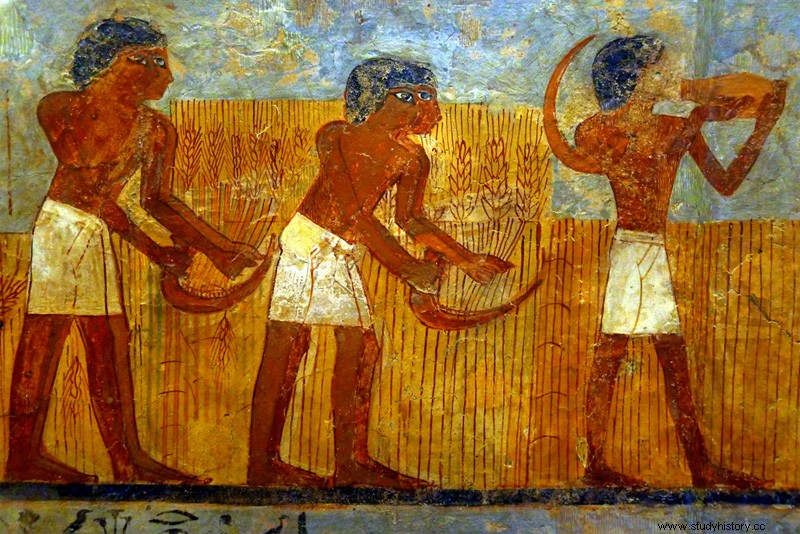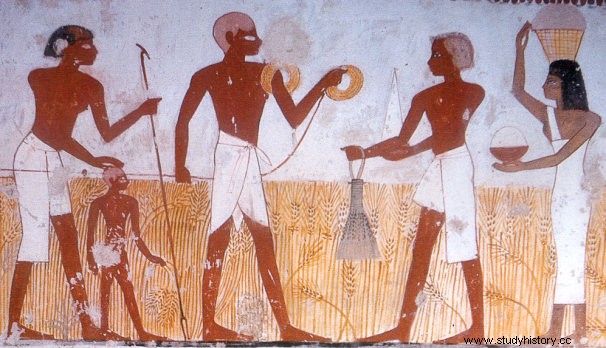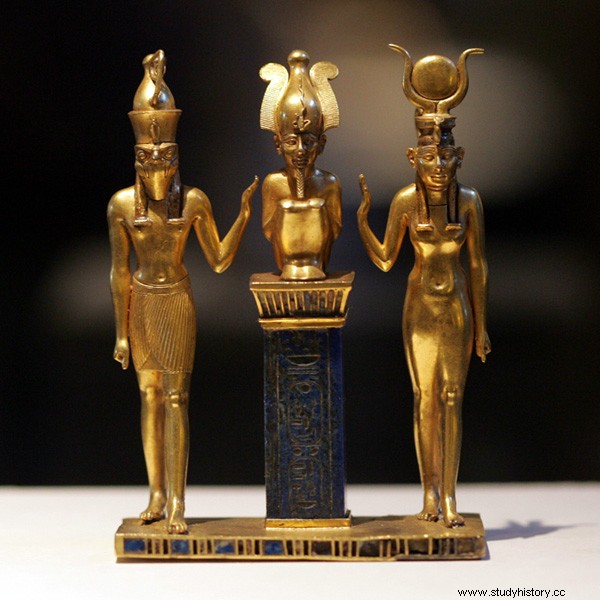The pre-dynastic period does not mark the official beginning of the history of Egypt which starts from the thinite period . At the beginning of the pre-dynastic period, the Egyptians already made arrows, harpoons and pots. They use ochres as dyes, crush harvested products with millstones, sew animal skins, work bones with scrapers, braid, etc.
AROUND 9,000 B.C. AD

Beginning of farming:
At the beginning of the pre-dynastic period , ancient Egypt is a long and narrow land stretching along the Nile . The Nile is the longest river of the world and measures 6,671 km. By its layout, it creates 2 large habitable regions:In the south, the Nile Valley extends between the current cities of Aswan and Cairo . To the north, the Nile Delta forms a triangle that starts at the level of the current city of Cairo and whose branches flow into the Mediterranean . The lands around the Nile Valley are not particularly hospitable as the rains are virtually non-existent. In addition, the noose of the desert is tightening and the floods of the Nile relentlessly obliterate in a muddy swamp every scrap of habitable land. Nevertheless, along the Nile is particularly favorable for agriculture because the soil is rich and fertile. Indeed, a layer of silt-rich minerals is deposited by the Nile after each flood . A good flood can reach a height of 8.32 meters and thus irrigates land far from the banks. But the river can also be capricious and in some years famine threatens the population when the flood is too low. Other years it can be too strong and it takes everything in its path. This is why the Egyptians revere and scrupulously thank the god of the Nile, Hâpî. In reality, the flooding of the Nile in Egypt is caused by the rains of Sudan and the snowfall on the southern mountains.
– From June until September , it’s flood season called Akhet.
– From October to February , it's plantation season called Péret.
– From March at May , it's harvest season , called Chemou.
Construction of the first agricultural villages:
Like the floods of the Nile become predictable, the Egyptians begin to build villages and coordinate agricultural work to irritate their lands. They find a way to regulate the waters by creating channels that communicate with the Nile and which make it possible to control the irrigation of the land. For this, they put in place an incredible and meticulous human organization that is not found anywhere else in the world at this time, except in the Middle East. The peasants also eat fish caught in the waters of the Nile.

Uncertainties and different sources:
According to some sources, during the pre-dynastic period , circa 5000 BC. BC, the northern part of Egypt (The Delta) was completely covered by water. These are the sea and the Nile from the south who built the Delta, the most fertile area of the country. The sea level was higher than today, and it was only from 3500 that this level began to drop, reaching its current level after 600 years. Other sources claim that around 10,000 – 8,000 BC. J.-C., an undetermined cataclysm caused radical changes:the bridge between Tunisia and Italy collapsed, leaving only the Maltese islands. The immense forests of northern Africa have become rare and the lagoons have turned into a desert of rock and sand. In Egypt , the Nile began to take on its face to reveal itself as a gigantic snake.
Specializations:
Egypt is one of the first regions to produce food surpluses that allow them to create other activities:cultural, technological, artistic, etc. Egyptians begin to plant and to weave linen, to draw scenes of everyday life, to model limestone vases, to sculpt bas-reliefs, working gold and ivory, making green makeup to protect the eyes of men and women, etc. They also make tools from finely polished stones or cut flint that are as sharp as steel.
Birth of Upper and Lower Egypt:
Gradually, the villages become cities and join to form 42 nomes (provinces) which end up being divided into two rival kingdoms:Upper Egypt to the South , which has a hot and dry climate and forms a sort of long oasis, and Lower Egypt to the north , watered by the arms of the Delta, which experiences a slightly milder Mediterranean climate, where it sometimes rains.

Birth of the Egyptian religion:
During the pre-dynastic period, the Egyptians worshiped many gods and goddesses which they personify by generally representing them with the body of a man and the head of an animal. It is therefore quite easy to recognize them. For the Egyptians, the gods are capricious and it is they who produce a good or a bad flood. (In the image: From left to right in the image:The Egyptian gods Re, Amun-Re, Osiris, Isis, Horus, Seth, Thoth, Anubis, Apopis). If the king does not worship the deities, the world can fall into chaos and return to the way it was originally...
Myth of the origins of the world:
Originally, the earth, the sky, the mountains, men and animals did not exist. There was only chaos liquid, an ocean of infinite dimensions:the Noun . It was the god Atum-Re (who would later be called Aton) who invented everything. Incarnation of the Sun, he came out of Noun by his own will and landed on a vertical stone that the obelisks later represented. He spat and squirted out his seed. From the liquid was born a divine couple :Shou , the Atmosphere, and Tefnut , Humidity. One day, the 2 gods disappeared and Atum-re was very sad and worried. So he shed tears of joy when he found the fugitives, and with his tears were born the men . Shou and Tefnut in turn fathered two other couples. The second pair associates Geb , god of the Earth, and Nut , goddess of the Sky, whose body is traversed during the day by the sun, which she swallows every evening to give birth to it every morning. It is often the lid of sarcophagi. Geb and Nout in turn conceived 4 children:Osiris, Seth, Isis and Nephthys . In most legends, the origin of the Earth is a liquid chaos fertilized by the sun; this representation may be due to the reality of the floods.

Myth of Osiris:
Osiris is the eldest son of Geb, the Earth, and of Nut, the sky and he inherits the royalty on the Earth. He is for the Egyptians, the first Pharaoh half-god half-man and he is endowed with infinite goodness and wisdom. For the Egyptians, it was he who brought together the nomadic tribes and taught them how to transform the damage of floods into benefits, how to repel the destruction of the desert by irrigation and tillage, how to work wheat to to make flour and bread, how to work the vine to make wine, barley to make beer, how to extract and work metals, how to write, how to become distinguished artists, etc. Then, his mission accomplished, he would have gone to Mesopotamia to instruct all peoples.
Seth , who shared the burning deserts of Egypt , felt a fierce jealousy towards his brother. So he killed him to seize the throne and then he threw his corpse into the Nile. Isis , sister and wife of Osiris , found his lifeless body. But Seth learned about it and, to get rid of the corpse for good, he cut it into 14 (or 16 depending on the version) pieces which he scattered across Egypt. Isis resumed her quest and gathered the members of her husband. Thanks to her talents as a magician and with the help of Anubis , god of mummification, she made the first mummy and brought the deceased back to life. They had a son, Horus , who avenged his father and succeeded him. However, Osiris could not return to Earth and he has reigned in the world of the dead ever since. It is recognized by its greenish corpse color and its mummy appearance. From now on, men will be mummified and resurrected like him. But only the righteous will enter his paradise.
Useful links:
- Large format book: Egyptian Mythology
- Illustrated large-format book: Illustrated Egyptian Mythology
